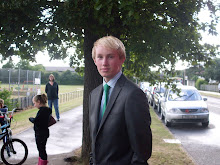1. In what ways does your media product use, develop or challenge forms and conventions of real media products?
My media product challenges the conventions of music magazines, the font of my masthead is unconventional, the font reflects the type of Indie genre that the magazine promotes. The background image is conventional in some ways, it is large and mixed in other layers, however, the image itself has no relation to the bands but to the masthead J.Y.C.B or join your countries band, and is a stereotypical image for WW1 and 2 posters with the king as the main image to recruit young soldiers. I conventionally used a barcode and a price as you would see in other magazines, this gives the sense of a genuine magazine and presents a good image. At the bottom of my front over I have included a competition to win a Jimmy Hendrix Guitar, this I feel, links perfectly with the genre of music, it also produces an incentive for my target audience to buy my magazine.
My contents page challenges most conventions of a stereotypical music magazine, however I have integrated layers to form a stylish effect. In my main story that speaks about the “delinquents from Dublin” I have linked the story with the font, in which I used an Irish, Celtic font. My secondary story can widen my target audience, as it is about homosexuality, this can relate to other readers who normally would not have bought the magazine. I decided to use two images on my contents page, this I feel keeps the page simplistic.
On my double page spread I have filed the background with one main image. This emphasises the seriousness of my story. The story is about a band member who was brutally murdered. I have used quotes of the deceased, and of his family, friends and band members. This I feel will create an effect on the target audience. I have used columns to separate the text. With text on each page I feel the attention will be drawn to the whole two pages instead of just one where the text is.
2. How does your media product represent particular social groups?
In my magazines I have used dark colours, this is because I aimed my magazine at a rock / indie audience and these colours I feel will attract them. The font I feel compliments the colours, black, white or blue. The bands I have included also relate to the audience I have targeted, they are conventional (but made up) indie and rock groups you would expect to hear about in magazines. The homosexuality story as shown on my contents page represents a gay audience well and will also widen my audience. The clothes worn in all my images represent a high social class as hey are well dressed. This however I do not feel will affect those who buy the magazine.
3. What kind of media Institution might distribute your media product and why?
Many institutions sell music magazines. From market stalls to big supermarkets like Tesco and ASDA. Wherever the magazine is sold I feel will affect the target audience, therefore I would choose carefully who distributed my magazine. For example Tesco and ASDA would be obvious choices, everybody shops in supermarkets and for people who buy magazines, they can always visit the magazine isle.
4. Who would be the audience for your media product?
My target audience is for people who like rock or indie music. As stated above I feel all the conventions, texts, images and colours I have used reflect this. However this is not specific, it can be for any age range, any social class or any gender, there are n boundaries to the type of music people like and magazines must accommodate this.
5. How did you attract/address your audience?
One of the main ways I have attracted my audience if on the front cover, I have included a competition to win a guitar. However I have aimed this directly at the audience I have used “BUT FREE FOR YOU!” to entice my audience. Also I have used an “exclusive interview” that readers will see, as never seen before this will also draw them in. Finally in my double page spread, I have used “as we remember in silence…” the use of the word “we” unites the audience and brings them into the magazine company, and gives them a feeling of it being their magazine.
6. What have you learnt about technologies in the process of constructing this product?
The main thing I have learned about the technologies used in the process is to save all your work on numerous hard drives and memory sticks in case you lose a copy. I started off not knowing how to use Photoshop, the tools were complicated and the settings were incomprehensible. I now know a small amount about it. For example the cut out tool is on the left and allows you to remove images and copy, cut and or paste onto other images. This is quick and easy to use and the main this I have used with my products.
7. Looking back at your preliminary task, what do you feel you have learnt in the progression from it to the full product?
On my double page spread I have learnt that the image must be able to separate into two pages, therefore, image and texts cannot be in the middle. On my front cover I have learnt how to portray that typical genre with pictures and colours. On my contents page I have discovered you must use pictures relevant to the stories, and that linking the fonts and colours with the mood and image that it creates a great effect.
By Marc Wilsher

No comments:
Post a Comment